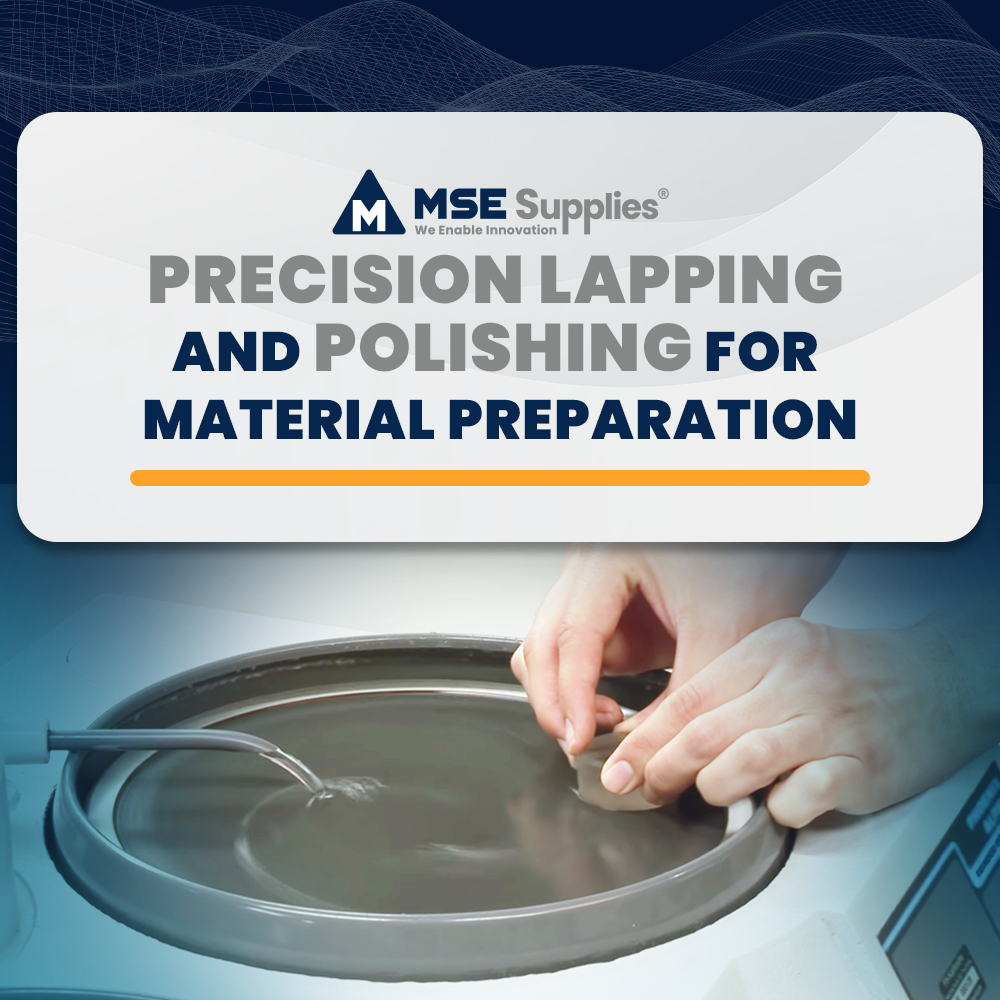6 Applications of Graphene In Energy Industry
Posted by MSE Supplies Admin on

Graphene is a material that consists of a single layer of carbon atoms arranged in a hexagonal lattice. Stacking layers of graphene on top of one another forms graphite, giving it a soft, slippery feel due to the layered structure.
Graphene is incredibly thin, flexible and strong, with exceptional electrical and thermal conductivity properties. Due to its unique properties, graphene has the potential to revolutionize various industries, including energy, electronics, transport, agriculture, wastewater treatment and health care.
This material has the potential to address certain global energy and pollution concerns. This quick guide examines some of the most common energy applications of graphene and how it plays a key role in meeting these energy demands.
What Is Graphene Used for in Energy Equipment?
Even though renewable energy sources are abundant and more environmentally friendly than the use of fossil fuel products, the occasional intermittency from solar panels and wind turbines requires a way to store and convert this energy to make it more efficient and cost-effective.
As a result, graphene has played a major role in the field of energy. It's considered one of the best solutions for clean and renewable energy on a large scale. Its high strength-to-weight ratio, low charging time and large surface area make it a great material for multiple energy technologies. Some uses of graphene include:
- Energy storage: Graphene is seen as a favorable performer for storing energy at a higher capacity and rapid charging capabilities.
- Solar energy: Due to graphene's ability to transport electrons, it's used as a transparent conductive film to create flexible and lightweight solar energy equipment.
- Energy generation: As graphene absorbs photons, it generates electrons, adding to its enhanced conductivity, light absorption and efficiency.
- Energy transmission: Graphene can transmit energy without overheating, meaning it could replace copper wires as a greener alternative in the future.
- Energy efficiency: Incorporating graphene in batteries, capacitors and smart energy systems can enhance their power lifetime, efficiency and output.
- Energy conversion: With a larger surface area, graphene electrodes can more easily convert one type of energy to another, such as solar to electrical.

6 Applications of Graphene in Energy Systems
Graphene's unique properties are shaping a more efficient and sustainable future for energy production, storage and utilization, as seen through its various applications below.
1. Solar Cells
Indium tin oxide (ITO) is used in solar cells because of its transparency, conductivity and thermal properties. Graphene has similar transparent and electrical properties, and the material's flexibility and 2D structure enable solar cells to be installed on any kind of surface.
Using electrodes made from graphene-based materials in solar cells improves the energy conversion more efficiently from solar energy into electrical energy. Graphene can also be used as a transparent conductive film in solar cells or to develop flexible and lightweight solar panels, which allow more light to reach the active layers.
2. Batteries
Graphene-based batteries are one of the most developed energy storage devices that use graphene. The material allows lithium batteries to perform better, charge faster and last longer.
- Li-ion batteries: Graphene can be used as an additive in graphite or coating on anodes.
- Lead-acid batteries: Graphene can be used instead of carbon black in lead-acid batteries, which improves their conductivity and dynamic charge acceptance while reducing water loss and sulfation.
- Li-sulfur batteries: Because graphene is resistant to overcharge and thermal runaway, using it in lithium-sulfur batteries lowers the cost of materials.
- Solid-state batteries: Solid electrolytes, anodes and cathodes of solid-state batteries can be made of graphene as a conductor.
- Supercapacitors: Graphene-based supercapacitors offer high energy density and fast charging capabilities.
3. Nuclear Power Plants
Producing heavy water to cool the reactors in nuclear power plants is costly and produces CO2 emissions. Graphene membranes provide a more affordable and greener solution to this process. In addition, graphene oxide particles dissolve easily in water and help absorb radioactive substances, forming lumps. These lumps can then be burned or recycled after removal.
This property means graphene can potentially be used to clean liquids for industrial use or replace metals in catalysis, especially in raw material extractions. Bringing metals up to the surface involves large amounts of water that contain natural radionuclides. Graphene oxide can clean this water and improve the area's environment.
4. Thermoelectricity
Thermoelectric generators generate electricity from thermal energy through the thermoelectric effect. The semiconducting materials create a difference in temperature between the elements, which causes the flow of electrons, generating an electrical current. The higher the difference, the higher the efficiency of the thermoelectric generator.
Graphene can be used in thermoelectric generators to improve energy conversion efficiency by enhancing heat transfer and electrical conductivity. Carbon-based materials, such as graphene, contribute to environmentally friendly solutions compared to materials that may contain toxic elements. Graphene's larger surface area, flexibility and light weight provide different sites for interaction with other materials in portable and adaptable composite films.
5. Distillation
Distillation is an energy-intensive process due to its temperature and vacuum requirements. Heat is needed to boil fluids to create vapor that can be condensed and collected. Additionally, some forms of distillation require a high vacuum to lower boiling points and allow the separation of components at lower temperatures. Due to the equipment and design of distillation equipment, large-scale production can be challenging.
A graphene membrane's physical properties can help distill ethanol at room temperature without needing a vacuum like in conventional distillation methods. This capability means it could potentially be used in alcohol distillation and fuel and water purification.
6. Fuel Cells
Another attribute of graphene's physical properties is that it can block small molecules like helium from passing through its membrane. This process drops fuel crossover and improves the conductivity and efficiency of fuel cells, which are emerging as energy-converting devices with low to no environmental effects. Graphene acts as a catalyst and lowers fuel crossover instances, thereby leading to more reliable and sustainable energy generation.
Benefit From Graphene's Properties With MSE Supplies
With graphene containing multiple extraordinary properties, its use in materials and energy-based technologies will continue to rise. It can significantly improve technical issues and optimize other materials and processes for better yields. Ongoing research and product development will continue to find more benefits of graphene in the energy industry and other innovative solutions.
MSE Supplies provides advanced materials and laboratory supplies of the highest quality, which you can use in cutting-edge research and development in your industry. We supply graphene in various forms and can customize your order according to particle size, film dimensions, foam thickness and more. Browse our full graphene collection today to get started.
Share this post
- Tags: Industry - Automotive & Aerospace, Industry - Industrial Process, Industry - Lithium Battery & Renewable Energy, Industry - Material Science, Industry - Semiconductor, Products - Graphene and Graphene Oxides, Products - Lithium Battery Materials & Tools




